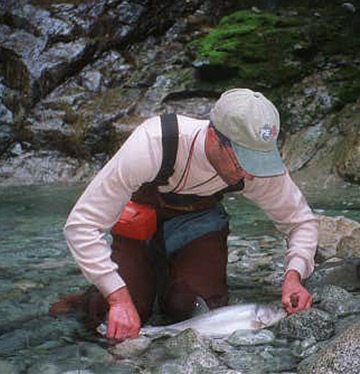Protecting fish
Puget Sound Energy shares the region's deep-rooted environmental ethic and embraces our responsibility to protect natural resources, including our cherished salmon runs.
Baker and Skagit rivers
Our biologists and fisheries technicians have been working for decades with Native American tribes and government agencies to boost salmon and trout populations, particularly in rivers where PSE has hydropower operations. In Washington's Baker River basin, home to PSE's largest hydroelectric project, our latest fish-restoration efforts have resulted in the three highest adult sockeye returns on record, all since 2012. The biggest run yet – 65,512 fish – occurred in 2023.
Because our two Baker River dams are too high for conventional fish ladders, we trap migrating fish and haul them up or downstream around the dams.
Part of this successful equation is our innovative Floating Surface Collector on Baker Lake. The $50 million apparatus, completed in 2008, attracts and safely holds juvenile salmon for downstream transport by "fish taxi." We built and put into service a second floating surface collector in 2013 on Lake Shannon to further boost the river’s propagation of juvenile sockeye. The largest outmigration on record occurred in 2023, with over 1.1 million juvenile sockeye transported.
In addition, we built a new fish hatchery along Baker Lake and an advanced, upstream trap-and-haul facility. Completed in 2010, both facilities are benefitting the river's once struggling salmon populations.
We also upgraded our sockeye spawning beach — a series of large, gravel-bottom pools with spring-fed water percolating up through them. This man-made, 20-year-old beach provides a controlled, predator-free environment for adult sockeye that greatly increases spawning success.
The new hatchery and renovated spawning beach are expected to result in a fivefold increase in hatched salmon fry in Baker Lake. A hatchery expansion completed in 2023 could push the future annual fry total to ~14.5 million.
More information
Baker River Project honored with prestigious National Hydropower Association award
Press release (04/05/2011)
Snoqualmie River
On the Snoqualmie River, home to our oldest hydropower facility, we are installing new flow-control equipment in our Plant 2 powerhouse that will ensure consistent outflows from the plant if an emergency shutdown occurs. The new equipment will prevent rapid changes in downstream river levels that could potentially strand fish in side channels. Additionally, we are protecting fish habitat along Kimball Creek and supporting a state Department of Fish and Wildlife fish-enhancement program in the upper Snoqualmie River watershed.











